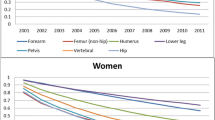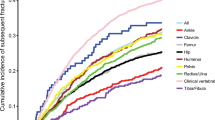Abstract
Summary
The incidence of non-hip femur fractures increased between 1984 and 2007, with an increase in the rates for women after 1996.
Introduction
Recent reports have suggested that non-hip femur fractures may be decreasing over time, similar to proximal femur fractures.
Methods
Incidence rates for non-hip femur fractures among Olmsted County, Minnesota, residents were assessed before and after 1995 when the oral bisphosphonate, alendronate, was approved in the USA.
Results
From 1984 to 2007, 727 non-hip femur fractures were observed in 690 Olmsted County residents (51% female [median age, 71.6 years] and 49% male [21.4 years]). Altogether, 20% of the fractures were subtrochanteric, 51% were diaphyseal, and 29% involved the distal femur. Causes included severe trauma in 51%, minimal to moderate trauma in 34%, and pathologic causes in 15%. The overall age- and sex-adjusted annual incidence of first non-hip femur fracture was 26.7 per 100,000 (25.0 per 100,000 for women and 26.6 per 100,000 for men). Incidence rates increased with age and were greater in women than men. Between 1984–1995 and 1996–2007, age-adjusted rates increased significantly for women (20.4 vs. 28.7 per 100,000; p = 0.002) but not for men (22.4 vs. 29.5 per 100,000; p = 0.202).
Conclusion
The incidence of first non-hip femur fractures rose between 1984 and 2007, with an increase in the rates for women after 1995.



Similar content being viewed by others
References
Melton LJ III, Kearns AE, Atkinson EJ et al (2009) Secular trends in hip fracture incidence and recurrence. Osteoporos Int 20:687–694
Weiss RJ, Montgomery SM, Al Dabbagh Z, Jansson KA (2009) National data of 6409 Swedish inpatients with femur shaft fractures: stable incidence between 1998 and 2004. Injury 40:304–308
Singer BR, McLaughlan GJ, Robinson CM, Christie J (1998) Epidemiology of fractures in 15,000 adults: the influence of age and gender. J Bone Joint Surg Br 80:243–248
Nieves JW, Bilezikian JP, Lane JM et al (2010) Fragility fractures of the hip and femur: incidence and patient characteristics. Osteoporos Int 21:399–408
Melton LJ 3rd, Crowson CS, O’Fallon WM (1999) Fracture incidence in Olmsted County, Minnesota: comparison of urban with rural rates and changes in urban rates over time. Osteoporos Int 9:29–37
Knowelden J, Buhr AJ, Dunbar O (1964) Incidence of fractures in persons over 35 years of age. A report to the M.R.C. Working Party on Fractures in the Elderly. Br J Prev Soc Med 18:130–141
Soveid M, Serati AR, Masoompoor M (2005) Incidence of hip fractures in Shiraz, Iran. Osteoporos Int 16:1412–1416
Baron JA, Karagas M, Barrett J et al (1996) Basic epidemiology of fractures of the upper and lower limb among Americans over 65 years of age. Epidemiology 7:612–618
Donaldson LJ, Cook A, Thomson RG (1990) Incidence of fractures in a geographically defined population. J Epidemiol Community Health 44:241–245
Wong PC (1966) Fracture epidemiology in a mixed southeastern Asian community (Singapore). Clin Orthop Relat Res 45:55–61
Hedlund R, Lindgren U (1986) Epidemiology of diaphyseal femur fracture. Acta Orthop Scand 57:423–427
Wang Z, Bhattacharyya T (2011) Trends in incidence of subtrochanteric fragility fractures and bisphosphonate use among the US elderly, 1996–2007. J Bone Miner Res 26:553–560
Arneson TJ, Melton LJ III, Lewallen DG, O’Fallon WM (1988) Epidemiology of diaphyseal and distal femoral fractures in Rochester, Minnesota, 1965–1984. Clin Orthop Relat Res 234:188–194
Shane E, Burr D, Ebeling PR et al (2010) Atypical subtrochanteric and diaphyseal femur fractures: report of a Task Force of the American Society for Bone and Mineral Research. J Bone Miner Res 25:2267–2294
Melton LJ III (1996) History of the Rochester Epidemiology Project. Mayo Clin Proc 71:266–274
Melton LJ III (1997) The threat to medical-records research. N Engl J Med 337:1466–1470
Commission on Professional and Hospital Activities (1978) International classification of disease, 9th revision, clinical modification, volume 1, diseases tabular list. Commission on Professional and Hospital Activities, Ann Arbor, MI
Marsh JL, Slongo TF, Agel J et al (2007) Fracture and dislocation classification compendium-2007: Orthopaedic Trauma Association Classification, Database, and Outcomes Committee. J Orthop Trauma 21(10 Suppl):S1–S133
Bergstralh EJ, Offord KP, Chu CP et al (1992) Calculating incidence, prevalence and mortality rates for Olmsted County, Minnesota: an update. Technical Report no. 49, Division of Biostatistics, Mayo Clinic, Rochester, MN
Berry G (1983) The analysis of mortality by the subject-years method. Biometrics 39:173–184
Bilezikian JP (2009) Efficacy of bisphosphonates in reducing fracture risk in postmenopausal osteoporosis. Am J Med 122(2 Suppl):S14–S21
Acknowledgments
The authors would like to thank Mary Roberts for help in preparing the manuscript.
Financial support
This project was supported in part by research grant AG-04875 and made possible by the Rochester Epidemiology Project (AG-034676) from the National Institute on Aging, US Public Health Service.
Conflicts of interest
None.
Author information
Authors and Affiliations
Corresponding author
Rights and permissions
About this article
Cite this article
Ng, A.C., Drake, M.T., Clarke, B.L. et al. Trends in subtrochanteric, diaphyseal, and distal femur fractures, 1984–2007. Osteoporos Int 23, 1721–1726 (2012). https://doi.org/10.1007/s00198-011-1777-9
Received:
Accepted:
Published:
Issue Date:
DOI: https://doi.org/10.1007/s00198-011-1777-9




